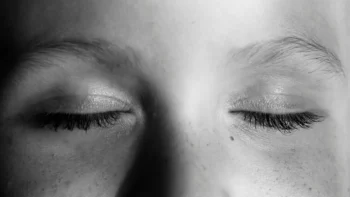We’ll get right to it: Nearsighted means your vision is blurry far away, and farsighted means your vision is blurry up close.
Both nearsightedness and farsightedness are refractive errors, which means the shape of your eye does not bend correctly, and your vision is blurry as a result. They are abnormalities that affect the eye’s ability to focus light on the retina. We’ll explain this later, but basically it just means your vision is blurry.
It’s very common to have a refractive error. It’s such a common vision problem that the National Eye Institute estimates 150 million Americans have a refractive error. The four most common refractive errors include nearsighted, farsighted, astigmatism, and presbyopia. Presbyopia is when your eyes become farsighted with age, which is the cause of your new reading glasses.
Are you in the 150 million? Here’s what your diagnosis of nearsighted or farsighted actually means.
What Does Nearsighted Mean?
This is what nearsighted vision looks like:

Your phone or book up close will be clear, but more distant items will be blurry.
Nearsightedness happens when the eyeball is longer than it needs to be and the eye is unable to focus the light coming in. The object you are looking at focuses before the retina so objects that are far away appear blurry. Another word for nearsighted is myopia.
Usually, a patient notices a change in their vision and makes an appointment with an eye doctor to get glasses or vision correction surgery. Nearsightedness can develop at any age, but it is most commonly diagnosed in school-age children.
In most patients, nearsightedness levels out in early adulthood, but there are types of myopia where the patient’s vision never stabilizes. It continues to get progressively worse throughout life.
Myopia is the most common type of refractive error. You can wear glasses or contacts to sharpen your vision, and you can also fix it with surgery. Even if you have a high prescription or astigmatism, you can get vision correction surgery to bring your vision back to 20/20 or better.
What Does Farsighted Mean?
This is what farsighted vision looks like:

See how her phone is blurry but she is in focus? Closer objects will look blurry and distant objects will look clear.
Hyperopia is another word for farsighted. It just means your vision is blurry up close, but clear at a distance.
Just how nearsightedness is caused by a lengthened eyeball, farsightedness is caused by a shortened eyeball. This makes the light focus past the retina.
This makes it difficult to focus on the computer or read a book. Children who are farsighted may have a hard time finishing work at school because they can’t see properly up close.
Farsightedness isn’t as common as nearsightedness, but it is still quite common. It often feels like a headache or eye strain before the patient realizes their vision is actually blurry.
Nearsightedness and Farsightedness are Treatable
Glasses and contacts are the most common ways to correct vision problems. You can fix your blurry vision with LASIK, PRK, or ICL as well, though.
There are ways to live without vision problems and without contacts or glasses! Our ophthalmologists are trained in vision correction surgery, and they work hard to give every patient a great experience and even greater vision. Feel free to contact us if you are looking for an ophthalmologist in Las Vegas!





